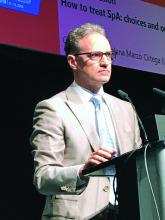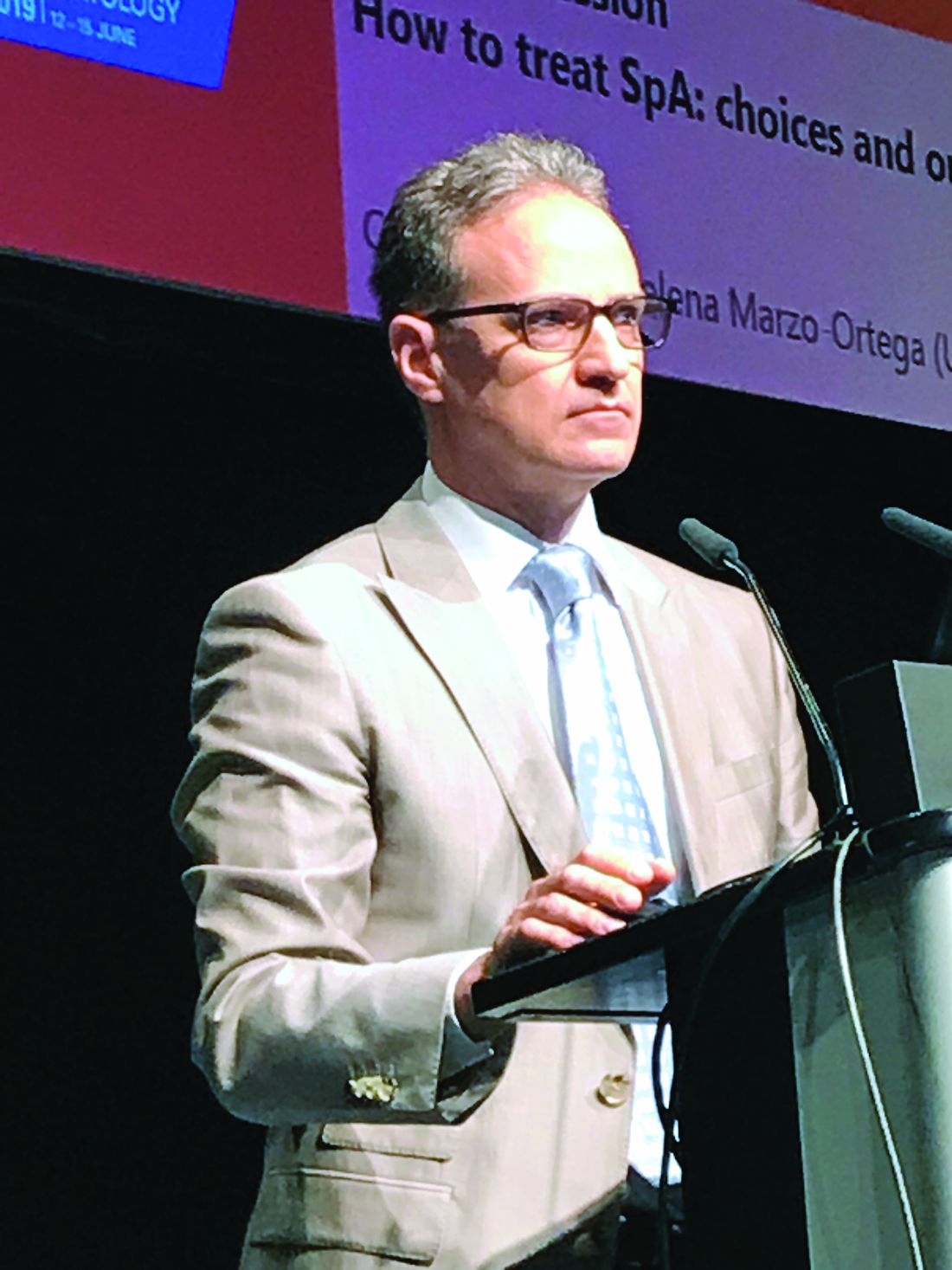User login
MADRID – In axial spondyloarthritis patients who discontinue a tumor necrosis factor inhibitor (TNFi), there does not appear to be any advantage for using the anti–interleukin-17 biologic secukinumab over a different tumor necrosis factor inhibitor for next therapy, according to an analysis presented at the European Congress of Rheumatology.
“Switching to secukinumab [Cosentyx] might even be inferior in many patients,” according to Adrian Ciurea, MD, of the clinic for rheumatology at University Hospital Zürich.
This conclusion was reached in a retrospective analysis of axial spondyloarthritis (axSpA) patients enrolled in the Swiss Clinical Quality Management Cohort. Although Dr. Ciurea said that a prospective trial is needed to confirm the findings, this study was conducted because there have been, up until now, “no data to choose between options” to guide this choice.
In this study of 382 axSpA patients who were candidates for a new biologic after discontinuing a previous TNFi, 275 were started on a different TNFi and 107 were started on secukinumab. Although about 60% of patients in both groups were HLAB27-positive, there were many other characteristics, including those related to disease severity, that were different, Dr. Ciurea acknowledged.
Specifically, the proportion of patients starting secukinumab treated with two or more TNF inhibitors was greater than that of patients switching to another TNFi (77.6% vs. 37.8%; P less than .001). In addition, patients in the secukinumab group had a higher baseline disease activity, more enthesitis, and greater axial impairment.
These were reflected in higher average Bath Ankylosing Spondylitis Disease Activity Index scores (6.1 vs. 4.8; P less than .001) as well as other baseline clinical scoring methods, such as the Bath Ankylosing Spondylitis Functional Index and the Maastricht Ankylosing Spondylitis Enthesitis Score.
However, baseline high-sensitivity C-reactive protein levels, number of swollen joints, or years of symptom duration were not significantly different between the groups, although all were numerically higher in the secukinumab group. The proportion of patients with uveitis was higher in the TNFi group. About 70% of patients in both groups had discontinued their prior TNFi for inadequate response.
For the primary assessment of drug survival on the new therapy, the median time was 1.1 years in the secukinumab group and 2.0 years in the group switched to a new TNFi, without adjustment for baseline characteristics and disease severity. After risk adjustment, this difference was no statistically significant.
“There was an interaction with gender, indicating a significantly higher risk of discontinuing secukinumab than a new TNFi in men,” according to Dr. Ciurea. This was not seen in women.
Previous studies have shown the response rate to a second TNFi is typically lower than for an initial TNFi therapy. Previous studies have also shown that response to secukinumab is lower in patients with previous TNFi experience than in those who are naive to biologics, Dr. Ciurea said. This analysis suggests that the likelihood of sustained disease control is not greater in TNFi-experienced patients who start secukinumab relative to a different TNFi.
When asked if the data had been analyzed to compare response in patients exposed to only one prior TNFi, Dr. Ciurea replied that this could not be done because the sample size was too small.
Although Dr. Ciurea acknowledged the limitations of retrospective studies with risk adjustments, he concluded that there does not appear to be an advantage for initiating secukinumab over starting a different TNFi in axSpA patients who require a switch from their current TNFi,
Even though he said that this is the first study to address this question objectively, Dr. Ciurea said, “A sufficiently powered, prospective, head-to-head trial is needed.”
Dr. Ciurea reported multiple financial relationships with pharmaceutical companies but received no funding for this study.
SOURCE: Tellenbach C et al. Ann Rheum Dis. 2019;78(Suppl 2):197. Abstract OPO237, doi: 10.1136/annrheumdis-2019-eular.2427
MADRID – In axial spondyloarthritis patients who discontinue a tumor necrosis factor inhibitor (TNFi), there does not appear to be any advantage for using the anti–interleukin-17 biologic secukinumab over a different tumor necrosis factor inhibitor for next therapy, according to an analysis presented at the European Congress of Rheumatology.
“Switching to secukinumab [Cosentyx] might even be inferior in many patients,” according to Adrian Ciurea, MD, of the clinic for rheumatology at University Hospital Zürich.
This conclusion was reached in a retrospective analysis of axial spondyloarthritis (axSpA) patients enrolled in the Swiss Clinical Quality Management Cohort. Although Dr. Ciurea said that a prospective trial is needed to confirm the findings, this study was conducted because there have been, up until now, “no data to choose between options” to guide this choice.
In this study of 382 axSpA patients who were candidates for a new biologic after discontinuing a previous TNFi, 275 were started on a different TNFi and 107 were started on secukinumab. Although about 60% of patients in both groups were HLAB27-positive, there were many other characteristics, including those related to disease severity, that were different, Dr. Ciurea acknowledged.
Specifically, the proportion of patients starting secukinumab treated with two or more TNF inhibitors was greater than that of patients switching to another TNFi (77.6% vs. 37.8%; P less than .001). In addition, patients in the secukinumab group had a higher baseline disease activity, more enthesitis, and greater axial impairment.
These were reflected in higher average Bath Ankylosing Spondylitis Disease Activity Index scores (6.1 vs. 4.8; P less than .001) as well as other baseline clinical scoring methods, such as the Bath Ankylosing Spondylitis Functional Index and the Maastricht Ankylosing Spondylitis Enthesitis Score.
However, baseline high-sensitivity C-reactive protein levels, number of swollen joints, or years of symptom duration were not significantly different between the groups, although all were numerically higher in the secukinumab group. The proportion of patients with uveitis was higher in the TNFi group. About 70% of patients in both groups had discontinued their prior TNFi for inadequate response.
For the primary assessment of drug survival on the new therapy, the median time was 1.1 years in the secukinumab group and 2.0 years in the group switched to a new TNFi, without adjustment for baseline characteristics and disease severity. After risk adjustment, this difference was no statistically significant.
“There was an interaction with gender, indicating a significantly higher risk of discontinuing secukinumab than a new TNFi in men,” according to Dr. Ciurea. This was not seen in women.
Previous studies have shown the response rate to a second TNFi is typically lower than for an initial TNFi therapy. Previous studies have also shown that response to secukinumab is lower in patients with previous TNFi experience than in those who are naive to biologics, Dr. Ciurea said. This analysis suggests that the likelihood of sustained disease control is not greater in TNFi-experienced patients who start secukinumab relative to a different TNFi.
When asked if the data had been analyzed to compare response in patients exposed to only one prior TNFi, Dr. Ciurea replied that this could not be done because the sample size was too small.
Although Dr. Ciurea acknowledged the limitations of retrospective studies with risk adjustments, he concluded that there does not appear to be an advantage for initiating secukinumab over starting a different TNFi in axSpA patients who require a switch from their current TNFi,
Even though he said that this is the first study to address this question objectively, Dr. Ciurea said, “A sufficiently powered, prospective, head-to-head trial is needed.”
Dr. Ciurea reported multiple financial relationships with pharmaceutical companies but received no funding for this study.
SOURCE: Tellenbach C et al. Ann Rheum Dis. 2019;78(Suppl 2):197. Abstract OPO237, doi: 10.1136/annrheumdis-2019-eular.2427
MADRID – In axial spondyloarthritis patients who discontinue a tumor necrosis factor inhibitor (TNFi), there does not appear to be any advantage for using the anti–interleukin-17 biologic secukinumab over a different tumor necrosis factor inhibitor for next therapy, according to an analysis presented at the European Congress of Rheumatology.
“Switching to secukinumab [Cosentyx] might even be inferior in many patients,” according to Adrian Ciurea, MD, of the clinic for rheumatology at University Hospital Zürich.
This conclusion was reached in a retrospective analysis of axial spondyloarthritis (axSpA) patients enrolled in the Swiss Clinical Quality Management Cohort. Although Dr. Ciurea said that a prospective trial is needed to confirm the findings, this study was conducted because there have been, up until now, “no data to choose between options” to guide this choice.
In this study of 382 axSpA patients who were candidates for a new biologic after discontinuing a previous TNFi, 275 were started on a different TNFi and 107 were started on secukinumab. Although about 60% of patients in both groups were HLAB27-positive, there were many other characteristics, including those related to disease severity, that were different, Dr. Ciurea acknowledged.
Specifically, the proportion of patients starting secukinumab treated with two or more TNF inhibitors was greater than that of patients switching to another TNFi (77.6% vs. 37.8%; P less than .001). In addition, patients in the secukinumab group had a higher baseline disease activity, more enthesitis, and greater axial impairment.
These were reflected in higher average Bath Ankylosing Spondylitis Disease Activity Index scores (6.1 vs. 4.8; P less than .001) as well as other baseline clinical scoring methods, such as the Bath Ankylosing Spondylitis Functional Index and the Maastricht Ankylosing Spondylitis Enthesitis Score.
However, baseline high-sensitivity C-reactive protein levels, number of swollen joints, or years of symptom duration were not significantly different between the groups, although all were numerically higher in the secukinumab group. The proportion of patients with uveitis was higher in the TNFi group. About 70% of patients in both groups had discontinued their prior TNFi for inadequate response.
For the primary assessment of drug survival on the new therapy, the median time was 1.1 years in the secukinumab group and 2.0 years in the group switched to a new TNFi, without adjustment for baseline characteristics and disease severity. After risk adjustment, this difference was no statistically significant.
“There was an interaction with gender, indicating a significantly higher risk of discontinuing secukinumab than a new TNFi in men,” according to Dr. Ciurea. This was not seen in women.
Previous studies have shown the response rate to a second TNFi is typically lower than for an initial TNFi therapy. Previous studies have also shown that response to secukinumab is lower in patients with previous TNFi experience than in those who are naive to biologics, Dr. Ciurea said. This analysis suggests that the likelihood of sustained disease control is not greater in TNFi-experienced patients who start secukinumab relative to a different TNFi.
When asked if the data had been analyzed to compare response in patients exposed to only one prior TNFi, Dr. Ciurea replied that this could not be done because the sample size was too small.
Although Dr. Ciurea acknowledged the limitations of retrospective studies with risk adjustments, he concluded that there does not appear to be an advantage for initiating secukinumab over starting a different TNFi in axSpA patients who require a switch from their current TNFi,
Even though he said that this is the first study to address this question objectively, Dr. Ciurea said, “A sufficiently powered, prospective, head-to-head trial is needed.”
Dr. Ciurea reported multiple financial relationships with pharmaceutical companies but received no funding for this study.
SOURCE: Tellenbach C et al. Ann Rheum Dis. 2019;78(Suppl 2):197. Abstract OPO237, doi: 10.1136/annrheumdis-2019-eular.2427
REPORTING FROM EULAR 2019 CONGRESS

